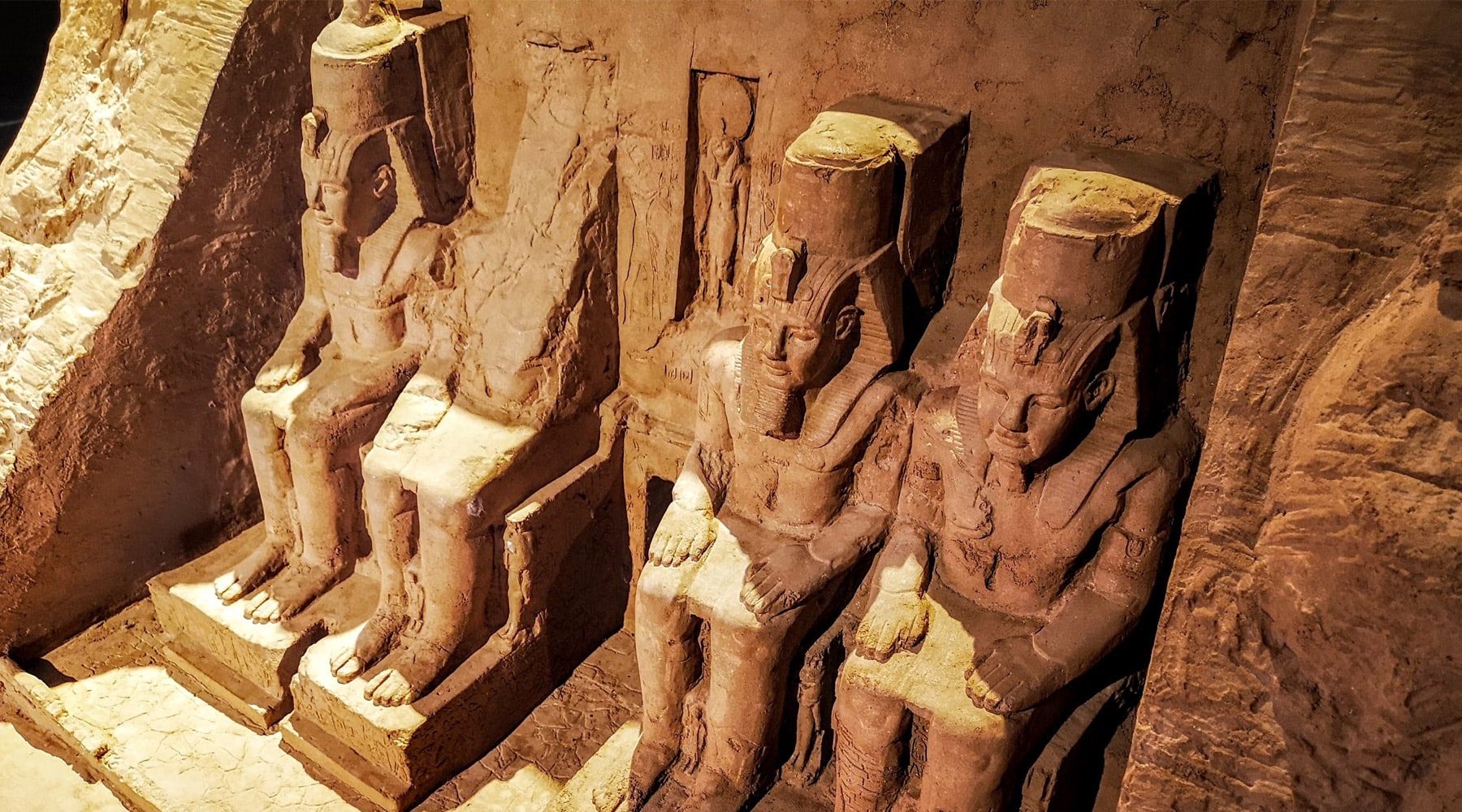The Abu Simbel Temples stand as one of Ramses II’s most impressive architectural legacies. They not only symbolize the grandeur of his reign but also embody the ingenuity of ancient design. In a remarkable feat of engineering and international collaboration, the entire sanctuary was dismantled and reassembled piece by piece by a UNESCO-led global effort to save it from the rising waters of Lake Nasser, created by the Aswan High Dam.
The colossal stone sculptures that embellish the temple façade were intended to immortalize Pharaoh Ramses II, an ambition that has indeed been realized. Visitors today still find themselves in awe of these monumental structures, just as his ancient subjects once did.
Abu Simbel Temples History
During his reign, Ramesses II embarked on an ambitious building program throughout Egypt and Nubia – a region of immense importance due to its gold and other valuable trade resources. He constructed several magnificent temples across this area to demonstrate Egypt’s power and to culturally integrate the Nubian people into the Egyptian realm.
The most renowned of these are the rock-cut temples located near the modern town of Abu Simbel, on the border between Lower and Upper Nubia. The complex comprises two temples – the Great Temple dedicated to Ramesses II himself and the Small Temple built in honor of his beloved wife, Queen Nefertari. Construction began around 1263 BC and took approximately 21 years to complete.
Location and Climate
Abu Simbel is located in southern Egypt, near the border with Sudan, and falls under the administration of the Aswan Governorate. The nearest town, Wadi Halfa, lies approximately 66 km southwest. The site, like the city that was relocated due to the reservoir’s creation, now stands on higher ground to ensure its preservation.
A modern highway cuts through the Libyan Desert, linking Abu Simbel to Aswan. While it mainly serves tour buses transporting visitors to the temples, it also plays a role in supporting regional water projects near the reservoir.
The region experiences a desert climate characterized by extremely hot, dry days with almost no rainfall. During summer, temperatures commonly exceed 39ºC (up to 49ºC on occasion), while nighttime temperatures can drop below 22ºC. Winters are comparatively mild, with daytime highs around 26ºC (78.8°F) and cooler evenings sometimes dipping under 9ºC (48.2°F).
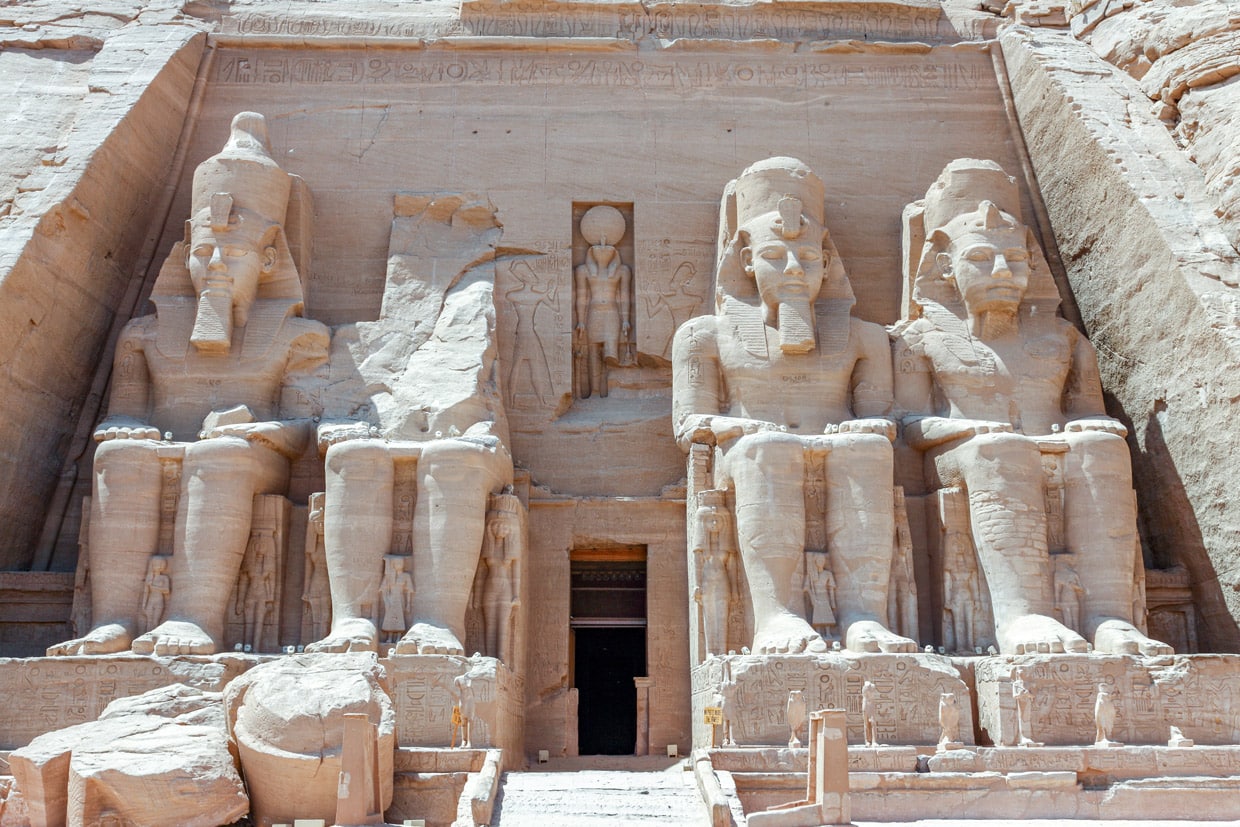
Abu Simbel Relocation
UNESCO’s concept of a shared world heritage lies at the heart of the Abu Simbel relocation project. Recognizing that the world’s historical legacy belongs to all, UNESCO rallied an international team to save these priceless monuments from the impending threat of Lake Nasser’s floodwaters. In the mid-1960s, this unprecedented operation saw the temples dismantled stone by stone and reassembled 61 meters above their original location.
Between 1963 and 1968, over 15,800 stone blocks were carefully relocated with support from more than 51 nations. In 1979, Abu Simbel, along with other regional landmarks, was rightfully designated as a UNESCO World Heritage Site, establishing its importance on a global scale.
Within the complex, the larger temple is dedicated to the gods Ra-Harakhty, Ptah, and Amun, as well as to Pharaoh Ramesses II himself. The smaller sanctuary, often referred to as the Small Temple, honors Queen Nefertari – one of the rare instances in history when a pharaoh built a temple for his wife.
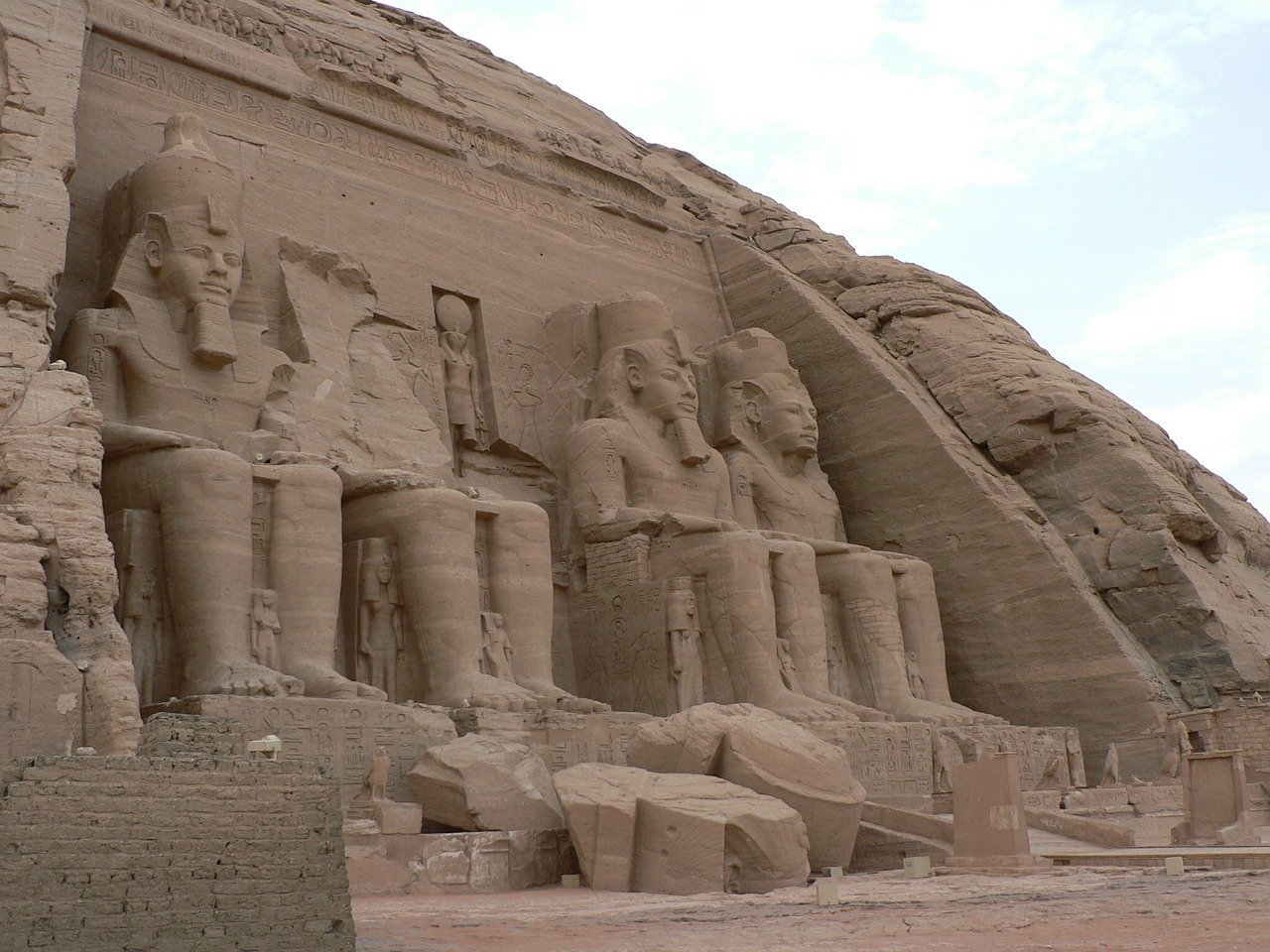
Great Temple
The Great Temple, which took nearly twenty years to complete, was finished in the 24th year of Ramses II’s reign. Dedicated to the deities Amun, Ra-Horakhty, Ptah, and the divine representation of Ramesses himself, it was among the largest and most significant temples of ancient Egypt.
Entrance
At the temple’s entrance, four colossal statues of Ramesses II, seated in royal splendor, stand guard. Notably, one of these statues incurred damage from an earthquake – its head and middle section fell away during the relocation process. Surrounding the main sculptures are ten smaller statues depicting his family, including his mother, Queen Mut-Tuy, his wife, and his eight children.
Beyond the statues, the façade measures 34 meters in height and 30 meters in width. Here, a detailed frieze of 22 figures is carved into the stone, depicting a procession of adoration for the rising sun. The passage itself is adorned with reliefs showing Ramesses II venerating Ra Horakhty, whose image is prominently displayed in a grand niche.
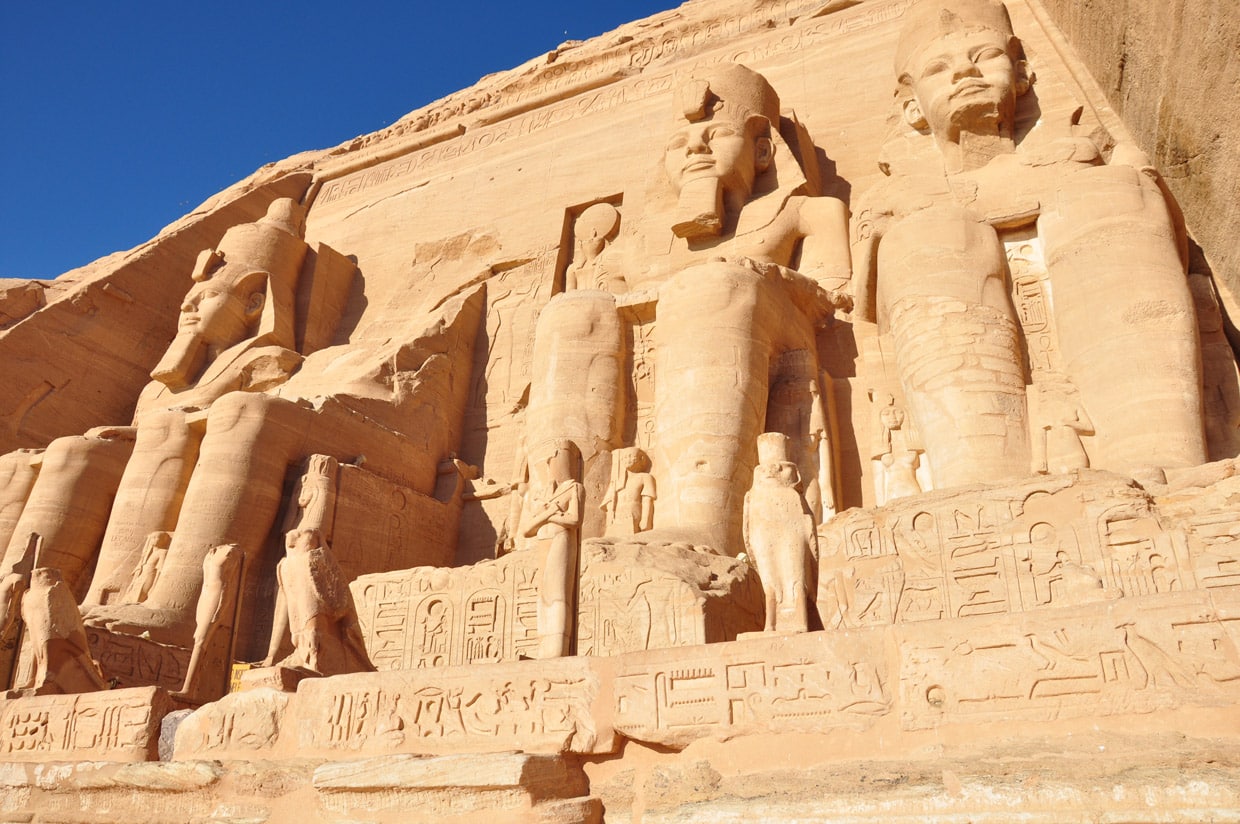
Interior
Inside, the temple follows a typical three-axial layout common among ancient Egyptian sanctuaries, with the rooms gradually decreasing in size from the entrance to the innermost sanctum. Its complexity and multiple side chambers continue to captivate visitors today.
The hypostyle corridor, or pronaos, spans 19 meters in length and 17 meters in width and is supported by eight massive Osiris columns, symbolizing themes of fertility, resurrection, and the eternal nature of the pharaoh’s rule. The walls of the corridor display intricate bas-reliefs that narrate Ramesses II’s military campaigns – most notably, a dramatic scene depicting the pharaoh in his chariot launching arrows at fleeing enemies.
Beyond the hypostyle hall lies a second pillared corridor adorned with four columns featuring detailed scenes of offerings and rituals dedicated to the Egyptian gods.
Small Temple
Just 105 meters northeast of the Great Temple is the Small Temple, devoted to Hathor and Queen Nefertari. This sanctuary highlights Ramesses II’s deep devotion to his queen – a practice not unprecedented in ancient Egypt, as seen with Akhenaton’s tribute to Nefertiti. The stone façade is adorned with two impressive statues that mark the entrance, each standing slightly over 11 meters tall.
Flanking the entrance further are smaller statues portraying the king and queen alongside symbols of royalty, such as the double crown. Remarkably, the statue of Nefertari rivals that of Ramesses II in size – a rare honor, as royal depictions of queens in ancient Egypt were typically smaller.
Ramesses II and Queen Nefertari visited Abu Simbel in the 24th year of his reign. Similar to the design of the Great Temple, the Small Temple also includes sculptures of princes and princesses lining the approach, underscoring its familial and ceremonial significance.
A Sacrosanct Site
The area surrounding Abu Simbel was considered sacred to Hathor long before Ramesses II selected it for these magnificent temples. By situating the temples in a holy area, Ramesses not only emphasized his divine status but also reinforced the spiritual significance of the site among the ancient Egyptians.
The orientation of the temples is particularly fascinating. For two days each year – on February 21 and October 21 – the rising sun penetrates the Great Temple, illuminating the statues of Ramesses and the deities within. These dates are believed to mark the pharaoh’s birthday and a significant royal celebration. Interestingly, while most temple icons are bathed in sunlight during these events, the statue of Ptah remains in shadow, symbolizing his association with the underworld.
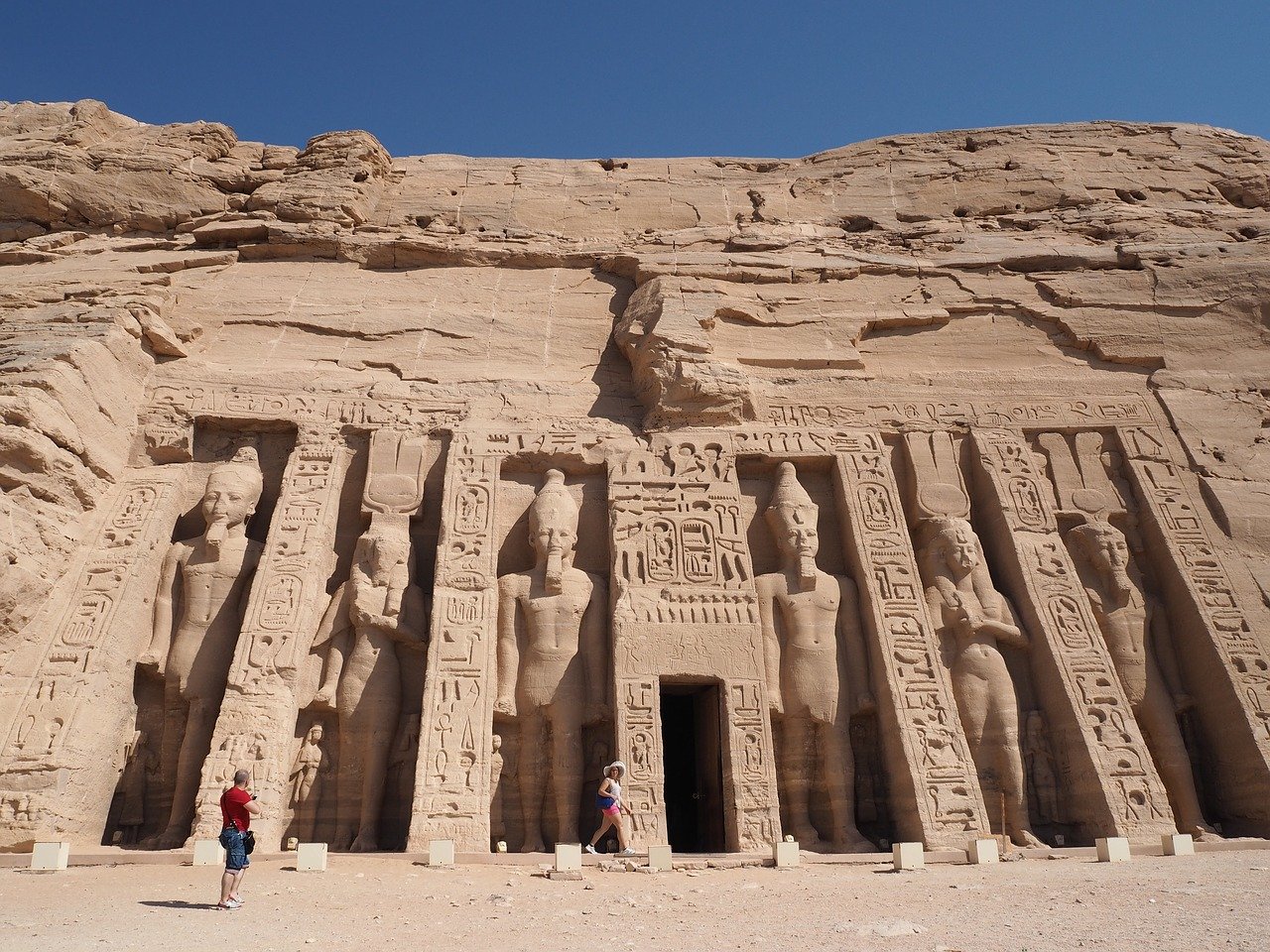
How to Get There?
Reaching Abu Simbel is an adventure in itself, and there are several ways to get there based on your preferences and schedule. The most popular options include:
By Tour Bus
Many visitors choose to join a guided bus tour from Aswan. These tours typically depart early in the morning—around 4 a.m. to 5 a.m.—to maximize sightseeing opportunities. Tours often include stops at other landmarks such as the Philae Temple and the Aswan High Dam, packing a full day of exploration into one trip.
By Private Taxi
For a more flexible itinerary, consider hiring a private taxi. It is recommended to pre-book through your hotel or a reputable local travel agent because only licensed taxi drivers are permitted to venture to Abu Simbel. This option allows you the freedom to depart at your own preferred time and explore the site at your own pace.
By Air
EgyptAir offers a quick and efficient flight route between Aswan and Abu Simbel, taking only about 20 minutes. Additionally, there are direct flights available from Cairo for those who want to combine their visit with a city break in the capital.
By Public Bus
For budget-conscious travelers, public buses operate daily from the Aswan bus station to Abu Simbel. Although the journey takes around four hours, it is an affordable way to experience local transportation and visit this iconic monument.
